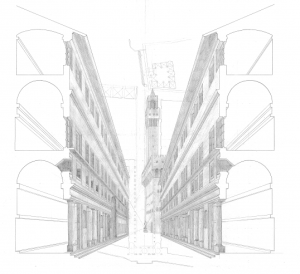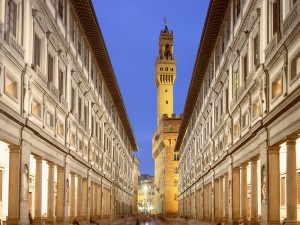While the world around us is constructed with parallel lines running parallel, our eyes never see it that way. What we see on our retina and what is actually there before us are extremely different. Euclidian geometry represents the idea that two parallel lines will stay true to form and remain parallel as they extend into space and is a representation of the real world (Wolfe). What our retina sees though is non-Euclidian in nature and results in parallel lines extending to a common vanishing point. So a drawing using Euclidian geometries is accurate in an object’s actual construction but would never be seen in that same manner by our eyes and in a sense creates a false image.
For my freshman year in architecture I had a class that was entirely focused on accurately hand drafting architectural elements. Throughout the class we did a series of projects that focused on drawing Euclidian shapes and using Euclidian geometries to portray buildings but also did drawings that were non-Euclidian in nature and more focused on the perspective that would also be seen from a person at the building. From an architectural standpoint there are advantages to both types of drawing even though we only perceive one way.
The first drawing below is of Adolf Loos’ Rufer House in Vienna, Austria. This was drawn using Euclidian geometry to give a true sense of the space and accurate dimensions of every element within it. Even though the building would never be seen this way it can accurately portray the buildings true proportions.

 [Image Credit http://www.greatbuildings.com/cgibin/gbi.cgi/Rufer_House.html/cid_20051213_kmm_img_7989.html]
[Image Credit http://www.greatbuildings.com/cgibin/gbi.cgi/Rufer_House.html/cid_20051213_kmm_img_7989.html]
This second drawing uses non-Euclidian geometries to represent what a person would experience if they actually visited the building. The drawing below is of the Palazzo Vecchio from the entrance of the Uffizi in Florence, Italy. If you were to actually visit the Uffizi then the normally parallel lines of the building would appear to converge on a vanishing point at Michelangelo’s David due to the monocular depth cue of linear perspective.
 [Image Credit http://miriadna.com/preview/uffizi-gallery-(florence)]
[Image Credit http://miriadna.com/preview/uffizi-gallery-(florence)]
While we may only experience the world from a non-Euclidian perspective, and the world is actually constructed from Euclidian geometries, both forms provide us with a representation of the world around us. As an architecture student it is useful to perceive the world in both ways to get a better sense of space even though our eyes only let us view it from a non-Euclidian perspective.
Works Cited
Wolfe, Jeremy M., Keith R. Kleunder, and Dennis M. Levi. “Sensation & Perception: Eye Structure.” Sensation & Perception: Eye Structure. N.p., n.d. Web. 17 Mar. 2014.
